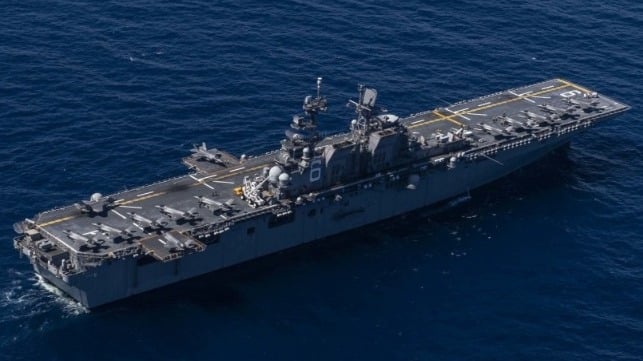U.S. Navy Shipbuilding Delays Extend to Amphibs

The U.S. Navy's shipbuilding delays already affect new carriers, destroyers, frigates and subs, and the slowdown extends into the amphib fleet as well. Buried in Pentagon budget documents for FY2026 are two notes on the America-class (LHA) shipbuilding program: the next two "big deck" amphibs will each be delayed by a year. The cause is Ingalls' persistent labor shortage, which started during the pandemic and has proven difficult to fix.
The delays - first reported by USNI - will affect the future USS Bougainville and Fallujah (LHA-8 and LHA-9). These giant amphibious assault ships function like helicopter carriers for the Marine Corps, and they deploy with F-35B Lightning fighters on board. Bougainville is nearing completion and was expected to be in the Navy's hands in December of this year, but that has now been pushed back to August 2026. Fallujah will now likely deliver in September 2030.
The Navy said that it based its delayed completion dates on "early construction performance indicators related to shipyard labor challenges." Labor issues have been reported at Ingalls before, driven by a comparatively tight job market and by a wage scale that many new entrants do not find attractive.
"People can go do far less difficult things for just about the same money from an entry wage standpoint," Ingalls' Shipbuilding President Kari Wilkinson told Breaking Defense last year. "We have a lot of physical capacity. It’s about people, and it’s about our ability to ramp up and retain should we take on more work than we already have."
The yard is working to address that issue with a full-court press - outreach to schools and educators; recruitment efforts targeting students in the nationwide Job Corps program; and advocacy for federal action to raise shipyard wages, something that defense shipbuilders can't easily do on their own within the bounds of a government contract.
There is one option on the table. To speed up construction of nuclear vessels, the Navy came up with a proposal to reallocate funding from future warship purchases in order to pay for present-day wage raises, dubbed the Shipyard Accountability and Workforce Support (SAWS) plan. Targeted at nuclear shipbuilding, it would make the wage rates in the shipyard more competitive with pay in other, easier occupations. However, it failed to make the cut for the White House's FY2026 budget request.
HII CEO Christopher Kastner advocated for something like SAWS during a media briefing early this year, calling it "the most innovative approach to getting it done." Federal investment in a wage hike would reduce attrition, he said, and stabilize the shipbuilding industrial base. "We believe it still has a lot of merit," he said.
